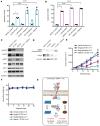Direct activation of PP2A for the treatment of tyrosine kinase inhibitor-resistant lung adenocarcinoma
- PMID: 30830869
- PMCID: PMC6478418
- DOI: 10.1172/jci.insight.125693
Direct activation of PP2A for the treatment of tyrosine kinase inhibitor-resistant lung adenocarcinoma
Abstract
Although tyrosine kinase inhibitors (TKIs) have demonstrated significant efficacy in advanced lung adenocarcinoma (LUAD) patients with pathogenic alterations in EGFR, most patients develop acquired resistance to these agents via mechanisms enabling the sustained activation of the PI3K and MAPK oncogenic pathways downstream of EGFR. The tumor suppressor protein phosphatase 2A (PP2A) acts as a negative regulator of these pathways. We hypothesize that activation of PP2A simultaneously inhibits the PI3K and MAPK pathways and represents a promising therapeutic strategy for the treatment of TKI-resistant LUAD. After establishing the efficacy of small molecule activators of PP2A (SMAPs) in a transgenic EGFRL858R model and TKI-sensitive cell lines, we evaluated their therapeutic potential in vitro and in vivo in TKI-resistant models. PP2A activation resulted in apoptosis, significant tumor growth inhibition, and downregulation of PI3K and MAPK pathways. Combination of SMAPs and TKI afatinib resulted in an enhanced effect on the downregulation of the PI3K pathway via degradation of the PP2A endogenous inhibitor CIP2A. An improved effect on tumor growth inhibition was observed in a TKI-resistant xenograft mouse model treated with a combination of both agents. These collective data support the development of PP2A activators for the treatment of TKI-resistant LUAD.
Keywords: Lung cancer; Oncology; Phosphoprotein phosphatases; Therapeutics; Tumor suppressors.
Conflict of interest statement
Figures




References
Publication types
MeSH terms
Substances
Grants and funding
LinkOut - more resources
Full Text Sources
Other Literature Sources
Medical
Research Materials
Miscellaneous

